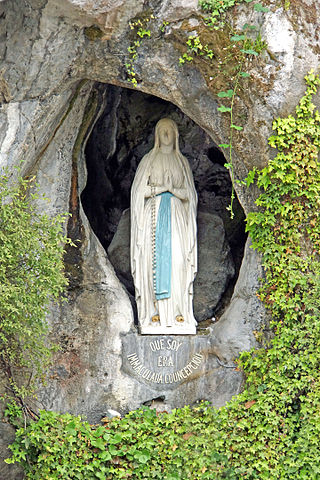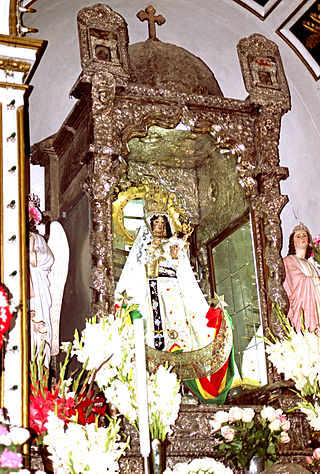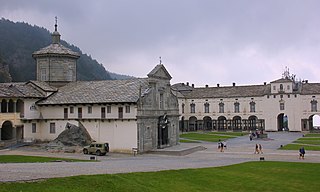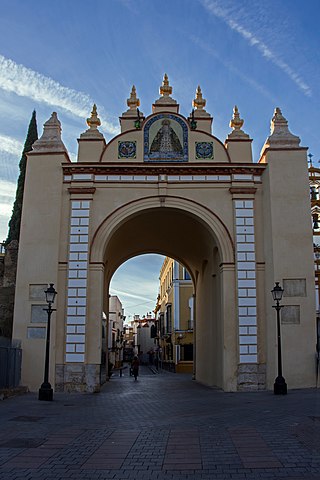
Our Lady of the Rosary of Chiquinquirá or the Virgin of Chiquinquirá, popularly known in Venezuela as "La Chinita", is a Marian title of the Blessed Virgin Mary associated with a venerated image in the northern Andes region. She has been for centuries the highly appreciated patron saint of Colombia and adjacent regions of Venezuela, being the center of important traditional festivities at the beginning of Christmas, accompanied by local music.

The Infant Jesus of Prague is a 16th-century wax-coated wooden statue of the Child Jesus holding a globus cruciger of Spanish origin, now located in the Discalced Carmelite Church of Our Lady of Victories in Malá Strana, Prague, Czech Republic. First appearing in 1556, pious legends claim that the statue once belonged to Teresa of Ávila and was consequently donated to the Carmelite friars by Princess Polyxena of Lobkowicz in 1628.

Our Lady of Lourdes is a title of the Virgin Mary. She is venerated under this title by the Roman Catholic Church due to her apparitions that occurred in Lourdes, France. The first apparition of 11 February 1858, of which Bernadette Soubirous told her mother that a "Lady" spoke to her in the cave of Massabielle while she was gathering firewood with her sister and a friend. Similar apparitions of the "Lady" were reported on 18 occasions that year, until the climax revelation in which she introduced herself as: "the Immaculate Conception". On 18 January 1862, the local Bishop of Tarbes Bertrand-Sévère Laurence endorsed the veneration of the Blessed Virgin Mary in Lourdes.

José Gómez Ortega, commonly known as Joselito, was a Spanish matador in the early twentieth century.

A canonical coronation is a pious institutional act of the pope, duly expressed in a formal decree of a papal bull, in which the pope bestows the pontifical right to impose an ornamental crown, a diadem or an aureole to an image of Christ, Mary or Joseph that is widely venerated in a particular diocese or locality. The act was later regulated to Marian images only, through the De coronatione imaginum B.V. Mariae that was issued on 25 March 1973.

Holy Week in Seville is one of two biggest annual festivals in Seville, Andalusia, Spain, the other being the Feria de Abril, which follows two weeks later. It is celebrated in the week leading up to Easter, and features the procession of pasos, floats of lifelike wooden sculptures of individual scenes of sorrowful Mysteries of the Rosary, or images of the grieving Virgin Mary.

Macarena is one of the eleven districts into which the city of Seville, capital of the autonomous community of Andalucía, Spain, is divided for administrative purposes. It is located in the north of the city, bordered to the south by the Casco Antiguo and San Pablo-Santa Justa suburbs, to the east and north by Norte and to the west by Triana. It covers the area between the Guadalquivir River and the Carmona Highway and from the SE-30 ring-road in the north to the Ronda del Casco Antiguo. It contains smaller neighbourhoods such as León XIII, Miraflores, and the Polígono Norte as well as the Miraflores park along the SE-30. The district contains the Andalucian Parliament, the Torre de los Perdigones in the park of the same name, and the Hospital Universitario Virgen Macarena

Our Lady of the Fountain in Caravaggio is a purported Marian apparition of the Blessed Virgin Mary at Caravaggio, Lombardy, Italy in 26 May 1432.
Our Lady of Charity is a celebrated Marian title of the Blessed Virgin Mary venerated in many Catholic countries.

The Virgen de Copacabana is the patron saint of Bolivia. She is venerated in Bolivia during her feast day of 2 February, the day of the Purification of Mary, or feast of the Virgen de la Candelaria. She is also venerated on 5 August with her own liturgy and popular celebration.

The Via Crucis to the Cruz del Campo in Seville, Andalusia, Spain is believed to be Spain's only Via Crucis that runs through the streets of a city. It is the basis of the famous traditions of Holy Week in Seville. Since the Via Crucis was first laid out in 1521, both the starting and ending points have changed, as has the number of stations.

In the Catholic Church, several locations around the world invoke the patronage of the Immaculate Conception. Catholic diocesan authorities with the expressed and written approval of the Pope in countries including the United States, Brazil, Korea, the Philippines and Spain designate the Blessed Virgin Mary as their principal patroness.
Worldwide The Confraternity of the Immaculate Conception of the Blessed Virgin Mary is one of the oldest lay apostolates still operating in the Roman Catholic Church, having been part of the Congregation of the Marians of the Immaculate Conception founded by Stanislaw Papczynski. "The Blessed Marian Founder fervently encouraged his spiritual sons to establish confraternities of the Immaculate Conception at Marian churches. 'The first laws of the Order of 1694-1698 speak of this already."
There are numerous sights and landmarks of Seville, Spain. The most important sights are the Alcázar, the Seville Cathedral, and the Archivo General de Indias, which are UNESCO World Heritage Sites.

The Sanctuary of Oropa is a group of Roman Catholic buildings and structures in Oropa, frazione of the municipality of Biella, Italy. It is located at a height of 1,159 metres in a small valley of the Alpi Biellesi.

The Puerta de la Macarena, also known as Arco de la Macarena, is one of the only three city gates that remain today of the original walls of Seville, alongside the Postigo del Aceite and the Puerta de Córdoba. It is located in the calle Resolana, within the barrio de San Gil, which belongs to the district of Casco Antiguo of the city of Seville, in Andalusia, Spain. The gate faces the Basílica de La Macarena, which houses the image of the Our Lady of la Esperanza Macarena, one of the most characteristic images of the Holy Week in Seville.
Procession at Seville and bullfighting Scenes is a non-fiction short film created by Auguste and Louis Lumière between 1898 and 1899. The Lumière brothers used a cinematograph to film this motion picture in Seville, Spain.

Our Lady of Consolation or Mary, Comforter of the Afflicted is a title of the Blessed Virgin Mary venerated in the Catholic Church.

Juan Manuel Rodríguez Ojeda (1853–1930) was a Spanish embroiderer and designer who contributed his works and innovations to the aesthetic change that occurred in the brotherhoods of Seville's Holy Week in the early years of the twentieth century.
Esperanza Elena Caro (1906–1985) was a Spanish embroiderer from Seville. She is remembered for the many richly embroidered religious works she created, especially those created after she took over the family workshop in 1943. Prominent works include the embroidered mantles and insignia she created over the years for the Virgen de Madre de Dios de la Palma and the Esperanza de Triana in connection with the Holy Week processions in the city. In 1971, she was honoured with the Gold Medal of Labour.


















